The Rife on a sunny spring day and a members front garden in Ferring

A member writes: It has been glorious the last few days on Highdown, with views from the Isle of Wight to the Windfarm and Brighton. On a very clear day it is possible to see Portsmouth’s Spinnaker Tower but only at a height from horseback, The Cathedral is easier to pick out. The mass exercising of dogs has ceased and most walkers are behaving. Skylarks are common both high up and when canoodling on the ground. There are several rafts of molehills. On the chalk slopes crows and jackdaws abound with isolated pied wagtails and a redwing in flight. A few goldfinches are around and we are waiting for swallows to return to their old nests in the stables. The badgers’ set along the ridge to Angmering has collapsed and they may have transferred to a second old set near the bottom of Hangleton Lane. Blackthorn for sloe berries and gin later is brilliant. Cow parsley abounds, the first time for years that it has been apparent throughout a winter.
If you walk up the lane, the first field on the right houses two huge hunters, Captain is in retirement and Duke is too difficult to ride. Please don’t feed them, some have tried as shown by carrots thrown into the field.’
So, all nature looks good and as it should be. However, there is something wrong down below; fewer trains, much less traffic on the 259, Honda and Peugeot are sleeping, no jets powering down approaching Gatwick.
……And David Bettiss points us to the web camera on the Peregrine’s nest on the roof of Chichester Cathedral: chichesterperegrines.co.uk
A member writes from Hangleton Lane: ‘Wild life revives: we have seen here apart from the resident blue and coal tits doves and pigeons, a fox, a moorhen, three ducks, a heron, a pheasant, and one small rabbit .What a difference it makes when Yeoman’s shuts down!’
Another, writes from off Langbury Lane, ‘We have the usual bird feeders, with anti-squirrel cages, but also a stick-on feeder for the window. This allows the less dexterous and bigger birds to obtain food just by landing on the open feeding area. Now they are all busily nesting, all the feeders are getting hammered and will get even more so once the chicks hatch. Now we all have more time at home, we can spend some of it allowing our feathered friends to entertain us. Seeing 15 starlings all challenging each other to get to the window feeder, I seriously wonder if any of them get anything. The savvy blackbirds wait underneath and pick up all the dropped seeds, etc. We have found the suet pellets with fruit or worm bits are scoffed by nearly all with sunflower hearts being almost universally rejected. The shallow water bowls nearly are also heavily used for bathing and drinking so it is a regular daily job to keep everything in order. The window bird feeders can be bought on Amazon as indeed can a huge variety of bird food and could provide an worthwhile diversion for people who are stuck at home, perhaps on their own.
The Group’s Chairman David Bettiss, accompanied by Tricia Hall, recently visited the local Chestnut Tree House Children’s Hospice to present a cheque for £600 raised by the sale of Tricia’s beautifully designed  Christmas Cards. The cards have been sold on behalf of Ferring Conservation Group exclusively to raise funds for the Hospice. The Group are delighted to have supported Chestnut Tree House over the last 8 years with many thousands of pounds raised in this way.
Christmas Cards. The cards have been sold on behalf of Ferring Conservation Group exclusively to raise funds for the Hospice. The Group are delighted to have supported Chestnut Tree House over the last 8 years with many thousands of pounds raised in this way.
Due to the ongoing Coronavirus situation, we are cancelling the next two members meetings in March and April. We’ll be reviewing the situation after that, and hope to be resuming the meetings once things have improved.
A small group of members made their Spring visit to the North Wall at Pagham Harbour, ably led by our local birdwatching expert Clive Hope. It was a windy and pretty chilly day, but this didn’t seem to put off the birds. Luckily we managed to avoid the threatened showers, but the wet winter meant that the nearby fields were generally flooded. This though did seem to attract many birds in good numbers, with an excellent total of 37 different species seen. 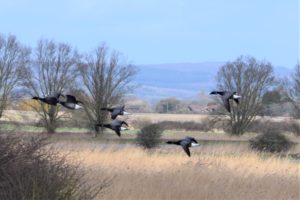
The highlights of the day were a large group of up to 16 Cattle Egrets which were showing well, alongside a healthy population of Grey Herons who were probably breeding in the nearby trees. It would be great if the Egrets follow suit and start breeding there. There were also in the region of 400 or so Black-Tailed Godwits – an impressive sight whenever they took to the air, something in the region of 40-50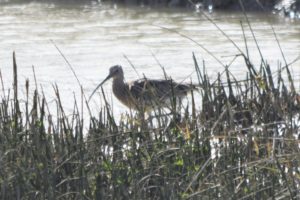 Curlew with their haunting winter calls, and scores of Dark-Bellied Brent Geese flying overhead to the nearby fields when the tide was rising in the harbour.
Curlew with their haunting winter calls, and scores of Dark-Bellied Brent Geese flying overhead to the nearby fields when the tide was rising in the harbour.
All in all, it was a most enjoyable birdwatching visit to a wonderful location which is only about half an hour away from us, and was capped off with a visit to the nearby cafe in Pagham village for lunch before returning home.
Please see below the information handout from Wadars relating to their recent planning application to develop their site to improve the animal wefare facilities there. It clearly outlines the benefits of the scheme and lays to rest the negative comments made by some. Ferring Conservation Group supports the application – the reference number is FG/6/20.
Wadars Rescue and Rehoming Centre, Ferring
Response to concerns raised on the planning portal.
Rewilding As a past livery yard, the property as it stands is almost entirely of concrete and therefore, encourages no natural wildlife beyond vermin and feral cats. We do attract swallows, which continue to nest in our permanent stables. Wadars specialises in the rescue and rehabilitation of wildlife. Our development plans support our work and include creating green spaces throughout the old stable yard, both natural meadow and landscaped, and increasing the number of trees. This is needed both for the improvement of the natural environment and for natural scent and sight barriers between species.
Building design & sustainability The only UPVC structures are those in the further development of the cattery. These are fully insulated units and provide the best possible environment for cats and kittens in a rescue environment. All other construction, including the kennels, are from robust traditional build materials, fully insulated, and include the use of photovoltaic panels for sustainable energy generation. Units are low impact and finished in brickwork and wood fibre cladding, giving a natural, virtually maintenance free finish.
Economic Development Since taking on the property in Hangleton Lane, Wadars has already provided an additional 10 jobs and more than 100 volunteering opportunities. This will increase further as the centre develops. ln additional, we are now providing valuable work experience for students involved in animals welfare and environmental courses at local colleges.
Kennels We have been transparent with our intentions for the property since purchasing in January 2014. When granting ‘change of use’ permission, Arun District Council placed caveats on the positioning and number of kennel units. This has been followed. We are below the capped number of runs and have placed the kennels facing east, at the eastern end of the property, as stipulated by Arun. These kennels are situated at least 100m from any existing residential property.
Barking dogs Dogs in kennels generally only bark when there are people around or they see another animal, they do not bark24/7. Kennels have been designed so that dogs do not face each other; they are separated into three individual blocks so they cannot set each other off. The outdoor exercise runs will be fully fenced with solid fencing so that dogs cannot see dogs in the next run or other animals such as horses. The fence running along the boundary between our kennel area and the neighbouring sand school will also be solid. lt is noted that the livery stables allow client dogs to roam loose and therefore, dogs are already interacting with their horses.
Development There were originally 86 stables on our property. The proposed footprint of the animal rescue and rehoming centre is less that the overall combined footprint of the original stables. The traffic generated by those original 86 stables is more than four times that of our proposed centre.
Staff accommodation The existing flint barn already has lapsed planning permission for conversion to residential. Our plan for the flint barn is purely for staff accommodation to ensure out of hours care for animals in need. The footprint of the barn remains unchanged. There are historic clauses on the property which prevents any owner from selling the barn separately and therefore, it cannot become general housing.
Surface water Considerable investigation has been put into the best drainage systems for surface water across the property. This has included specialist infiltration tests and the development of a drainage plan by specialist engineers, including direction of flood waters to a natural swale. This will also encourage more natural wildlife to the area.
Other centres owned by Wadars Wadars has no other property or centre(s), and never has had. The facility which we use in Lancing is a commercial boarding kennels and costs the charity more than f30,000 in kennelling charges every year
Other benefits
Wadars rehoming centre will allow our specialist animal welfare team to work on any behavioural or socialising needs that dogs and puppies might have before finding new forever homes for them. A dual purpose Training and Education centre will enable us to train and socialise dogs and puppies in our care; we can also invite the local community, especially localyouth groups and other community organi5ations, to learn about responsible pet ownership and wildlife awareness. A purpose built wildlife facility will allow us to expand the work of our Animal Rescue Officers in your community; it will also enable us to reduce stress for more wildlife casualties by caring for them here in Ferring, their natural environment, rather than having to transport them to other centres; journeys that often result in premature and unnecessary deaths of wildlife. Education is a key theme running throughout our proposals and providing placements for local college students studying for roles within the animal care sector is something that we have already begun to do, but which will feature heavily in our plans going forward.
Please note that there will be no work party this coming Tuesday – 3 March.
But please don’t forget the Rife Clean on Saturday 21 March starting at the far end of the Bluebird Cafe cafe cark by the toilets at 11am. Pickers, bags, high vis jackets and gloves are provided, and suggest that you wear wellies as likely to still be wet and muddy. Quite a lot of rubbish has been washed downstream during the floods and is sitting in the vegetation so we hope to see you there to help clear it up.
On a bright, chilly morning 17 members of Ferring Conservation Group met on the beach at the end of Sea Lane in Ferring. The challenge was to identify as many items as possible on the list that Tricia Hall, the Group’s guide for the morning, had provided. With a keen wind behind them the Group set off in an easterly direction carefully exploring the shoreline where there was a good chance that the recent storms had dislodged marine life from the seabed.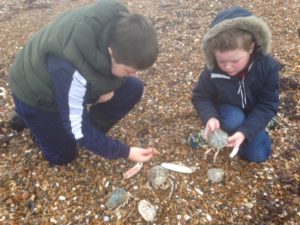
Members were soon surprised at finding many empty shells of large spider crabs, together with pincers and legs. Many of them spied with the keen eyes of two of the youngest participants, Thomas and Eoin Kearns.
Sea lemons (or sea slugs) were found amongst clumps of seaweed; including Sea Oak, Egg Wrack and Irish moss or Carragheen. It was reassuring to see that at least a small amount of Kelp was evident. Jane Hayman from the Group commented that ‘the byelaw to be introduced preventing fishing boats from entering the kelp beds off the Sussex Coast will help save this important marine habitat and hopefully allow the kelp to thrive once more’.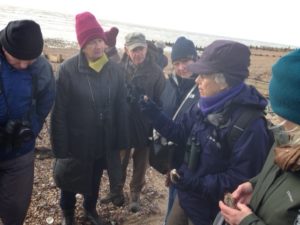
A Sea Squirt, a Starfish and also several kinds of Sponge were identified. Along with the usual egg cases of Sharks, Rays and Cuttlefish, lots of Cuttlefish bones were seen, especially baby ones.
Further along the beach the Group noticed the badly decomposed body of a Thornback Ray, a possible casualty of the recent stormy weather. On hearing the familiar ‘peep-ing’ call of the Oyster Catcher, attention was drawn to the water’s edge where many wading birds including Turnstones and Dunlins were searching for shellfish to eat. An excellent view of these birds was possible with the use of a powerful telescope, kindly provided by member Clive Hall.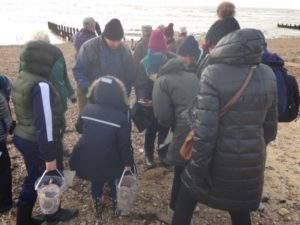
It was reassuring to find that only a small amount of plastic had been washed up but very disappointing to discover many lumps of palm oil. This edible vegetable oil comes from the fruit of oil palm trees and is used in almost 50% of packaged products found in supermarkets and also in animal feed, as well as being used as biofuel in many parts of the world (but not in the UK). It continues to be a major driver of deforestation of some of the world’s most diverse forests. Ships are regularly dumping large quantities of palm oil off the coast of Britain and although it is not poisonous to dogs, if eaten it can cause sickness and in extreme cases, pancreatitis and blockages.
A welcome stop for refreshments at Sea Lane Café gave the Group time to warm up with a hot drink, and before heading back to the starting point Tricia Hall was thanked for her time and the sharing of her considerable knowledge, which made the walk all the more interesting.
You may be interested in some upcoming events this year at the National Trust run historic farm at Saddlescombe, near Devil’s Dyke just north of Brighton and Hove as follows:
Farm Open Day on Sunday 28 June from 1030-1530, and a Heritage Open Day on Sunday 20 September also from 1030-1530. These are both free events but there is a £5 car park charge. There is also a cafe, farmers market and guided walks. The farm is situated between Poynings and the Devil’s Dyke road and signposted from the A27. You can also catch the number 77 bus from Brighton railway station and walk there from Devil’s Dyke itself.
There are also 2 Orchid days on Sunday 7 June and Tuesday 16 June from 1030, where there will be a guided walk with a ranger to search for a variety of wild orchids. There is a cost for this and tickets have to be booked via the National Trust website. More details of all the above days can be found there as well.